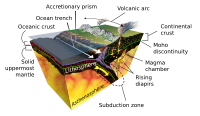
Photo from wikipedia
Abstract For magma chambers to form or volcanic eruptions to occur magma must propagate through the crust as dikes, inclined sheets and sills. Most models that investigate magma paths assume… Click to show full abstract
Abstract For magma chambers to form or volcanic eruptions to occur magma must propagate through the crust as dikes, inclined sheets and sills. Most models that investigate magma paths assume the crust to be either homogeneous or horizontally layered, often composed of rocks of contrasting mechanical properties. In regions that have experienced orogenesis, like the Andes, the crust has been deformed over several million years, resulting in rock layers that are commonly folded and steeply dipping. The assumption of homogeneous properties or horizontal layering then does not capture all of the potential magma path-crustal interactions. Here we tackle this problem by determining the effect of a crust made of steeply inclined layers in which sills and inclined sheets are emplaced. We combine field observations from a sill emplaced in the core of an anticlinal fold at El Juncal in the Chilean Central Andes, including lithologies, sill and fold limbs attitude, length and thickness with a suite of finite element method models to explore the mechanical interactions between inclined layers and magma paths. Our results demonstrate that the properties of the host rock layers as well as the contacts between the layers and the geometry of crustal structures all play an important role in magma propagation and emplacement at shallow levels. Sill propagation and emplacement in heterogeneous and anisotropic crustal segments change the crustal stress field promoting sill arrest, deflection or further propagation. Specifically, sills are more likely to be deflected when encountering shallow dipping layers rather than steeply dipping layers of a fold. Mechanically weak contacts encourage sill deflection due to the related rotation of the stress field and this effect is attenuated when the folded layers are steeper. These processes may change the amount and style of recorded surface deformation, with implications for monitoring of active volcanoes.
Journal Title: Earth and Planetary Science Letters
Year Published: 2021
Link to full text (if available)
Share on Social Media: Sign Up to like & get
recommendations!